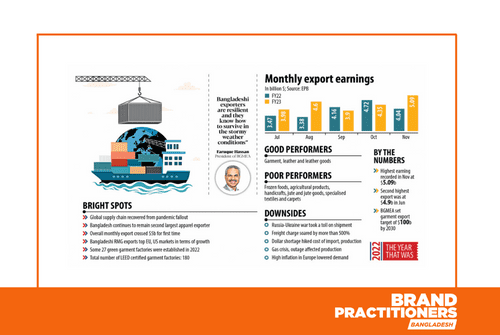Export stands out in turbulent year
Bangladesh’s export sector has demonstrated its strength and resilience in the face of difficult challenges in recent years. Despite the devastating Russia-Ukraine war, unprecedented freight costs, energy crisis, record inflation and a risk of recession that loomed large throughout 2018, the sector got off to a good start in 2019 and continued to perform well until August 2020 – even after the outbreak of the coronavirus pandemic and the resulting increase in production costs at home.
Despite a dip in September and October, shipments rebounded in November as international buyers began placing more orders. The export sector was one of the few bright spots for Bangladesh in a turbulent year.
Export earnings surpassed the $5-billion mark for the first time in the country’s history in November, due to robust growth in apparel shipment.
It was a great year for exports, with overall merchandise export growing 41.13% year-on-year to $4.85 billion in January. This figure reached an all-time high in November, with exports totaling $5.09 billion. The biggest contributor to this growth was the apparel shipment, which surged 42.5% to $4.09 billion in January and reached $5.09 billion by November.
The first sign that things were going to change came when European nations banned the use of Society for Worldwide Interbank Financial Telecommunications. Bangladesh’s exports to Russia soon took a hit, as the country lost the ability to easily make transactions with its neighbors.
However, local exporters quickly found alternative routes to ship goods to Russia, and began receiving payments in the Chinese currency instead of the US dollar. This allowed Bangladesh to continue doing business with its neighbors, albeit in a more roundabout way.
The recent 500% increase in freight costs has dealt a severe blow to the export sector, as the exchange rate for the US dollar has reached an all-time high of Tk 110. Exporters are struggling to compete in the global market due to the lower exchange rate they receive when cashing in their export proceeds.
Record inflation in the European Union and the United States has hit Bangladesh’s export earnings hard, as consumers have tightened their purse strings in anticipation of recession. Many international retailers and brands have unsold inventories of clothing items, which has further decreased demand.
The war and higher freight charges have affected the price of cotton, sending the cost of yarn in the local market higher. As the prices of cotton have fallen worldwide recently, yarn worth $3 billion has piled up with local textile factories.
Productivity at factories decreased significantly due to the power outages that have been occurring regularly since the government decided to implement load-shedding in order to protect the foreign currency reserves. This is because Bangladesh needs to import the fuel needed to generate electricity, and pausing the purchase of liquefied natural gas from global spot markets has forced the government to shut down many power plants, making the power supply situation even worse.
The Bangladesh Garment Manufacturers and Exporters Association (BGMEA), the platform for apparel exporters, announced in August its plan to raise apparel shipment to $100 billion by 2030, despite the gloomy global economy.
In 2022, Bangladesh retained its position as the second-largest apparel exporter globally after China.
“The demand for locally made garment items is still very high despite higher inflation in Europe,” said Senior Commerce Secretary Tapan Kanti Ghosh earlier.
He attributes the stellar export performance to the US-China tariff war, competitive prices, and the recent improvements in workplace safety conditions.
This year, Bangladesh also cemented its position as a reliable supplier of apparel items as the country has been among a few nations that have kept its factories open since the coronavirus pandemic hit the world in March 2020.
“Bangladeshi exporters are resilient and they know how to survive in the stormy weather conditions,” said Faruque Hassan, president of the BGMEA.
Throughout the crisis, local suppliers exported more to non-traditional markets such as India, China, Japan and Russia, along with traditional destinations, namely the EU, the US and Canada.
Bangladesh is also on its course to becoming a global manufacturing hub for value-added high-end garment items – a prospect that may go on to help the country boost export receipts.
Hassan said that by the end of the current year, Bangladesh’s share in the global apparel market will increase to 7.5% from the existing 6.4%.
However, the shipment of some potential sectors, except leather and leather goods, could not meet expectations due to the fall in demand in global markets owing to the volatile global economy.
For instance, frozen foods, agricultural products, handicrafts, jute and jute goods, specialized textiles and carpets performed poorly in terms of exports.
The president of the Bangladesh Jute Mills Association, Md Abul Hossain, has stated that the recent decline in exports is due to the rising cost of raw jute in the local market. He went on to say that “consumers are also not ready to pay more for jute goods because of the cost-of-living crisis. Consumers are looking for alternatives.”
Md Saiful Islam, president of the Metropolitan Chamber of Commerce and Industry, has said that shipments of goods are beginning to rebound sharply.
“International retailers and brands are cutting their reliance on China and moving to countries such as Bangladesh, Vietnam and Cambodia.”
“Sales centring Christmas are showing better performance as consumers are going to celebrate the occasion in a major way for the first time in three years.”
M A Razzaque, research director of the Policy Research Institute of Bangladesh, described 2022 as a mixed year for the export sector.
“Export grew in the first half before slowing down to some extent in the second half.”
While the exporters were supposed to benefit from the significant drop in value of the local currency against the dollar, they have not been able to as banks have been setting different exchange rates for the American dollar. This has negated any benefits that the currency depreciation could have had, said the economist.













